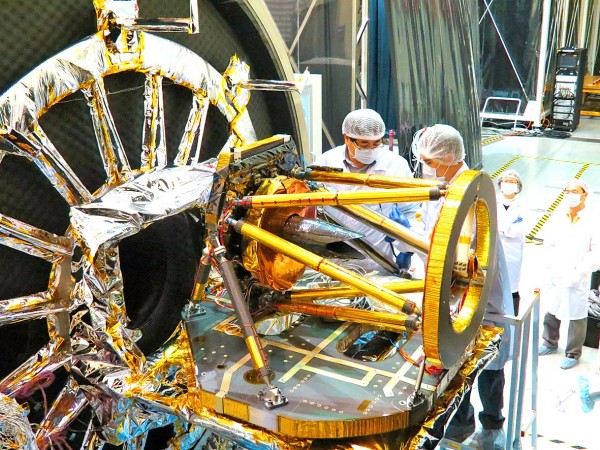《TAIPEI TIMES 焦點》 NARL details new satellite

National Applied Research Laboratories personnel examine the Formosat-5 satellite in Taipei in an undated photograph. Photo courtesy of the National Applied Research Laboratories
SPACE SENTRY? Engineer Huang Po-hsuan said that the craft would help with national security, as well as providing data for rescue missions and science projects
By Sean Lin / Staff reporter
The National Applied Research Laboratories (NARL) yesterday lifted the curtain on its Formosat-5 optical remote sensing satellite, which researchers said is the first Earth observation satellite entirely developed by Taiwan and boasts a higher resolution than its predecessor, Formosat-2.
The satellite’s primary optical payload, a remote sensing instrument (RSI), derives its strength from a series of optical lenses, with the main lens measuring 45cm in diameter with a 3,600mm focal length, NARL National Space Organization engineer Huang Po-hsuan (黃柏瑄) said.
The lenses take the form of a Cassegrain reflector, making it compact enough to fit into the tip of a rocket, Huang said.
He said the breadth of the device’s main lens is more than doubled and its focal length quadrupled compared with a single lens reflex camera with a super-telephoto lens, allowing it to achieve a resolution of 2m2 from 720km above the Earth.
Furthermore, the payload contains the world’s largest CMOS image sensor chip, which Huang said is a technical breakthrough thanks to Taiwan’s robust integrated circuit fabrication industry.
Cut from an 8-inch wafer, the chip integrates five individual image sensors, which traditionally would have been built separately, significantly helping image calibration, Huang said.
The RSI can store 128 gigabytes of data and process up to 925 megabytes of raw image data at any time, he added.
To simulate a space environment, researchers first measured imaging errors in standard gravity and then at negative-1 gravity, while fine-tuning the lenses to achieve the smallest possible margin of error, which stands at less than 100,000th of a degree and 7 micrometers, he said.
Huang said that shockproofing the device was no less daunting a task, as the lenses must not be displaced during the rocket’s launch, but at the same time must not be rigidly secured because they might break.
To meet this demand, the research team used specially designed support rings and tubes to hold the lenses in place, and encased the payload in an intricate titanium and carbon fiber shell.
The Formosat-5 is to be used to bolster national security and conduct environmental surveillance, and will significantly aid the nation in domestic and international rescue missions, as well as science projects, Huang said.
“In a nutshell, it is a super-large digital camera for space that can help with science projects,” he said.
Project leader Chang Ho-pen (張和本) said that the Formosat-5 could become a precursor of remote sensing satellites that utilize CMOS image sensors worldwide.
He said that although Earth observation satellites developed overseas use charge-coupled devices (CCD) as image sensors, the rights to that technology is held by only a handful of countries.
To use a CCD device, the Formosat-5 would be have to be limited to certain purposes, he said.
It makes more sense for Taiwan to develop its space program using a technology it has already mastered, he said, adding that CMOS has been widely used by commercial satellites.
National Space Organization Director-General Chang Guey-shin (張桂新) said that the satellite is undergoing final tests and is scheduled to be launched from Vandenberg Air Force Base in California in the first quarter of next year.
The lab embarked on the project in 2010 amd it is estimated to cost NT$3.66 billion (US$119 million).
新聞來源:TAIPEI TIMES











